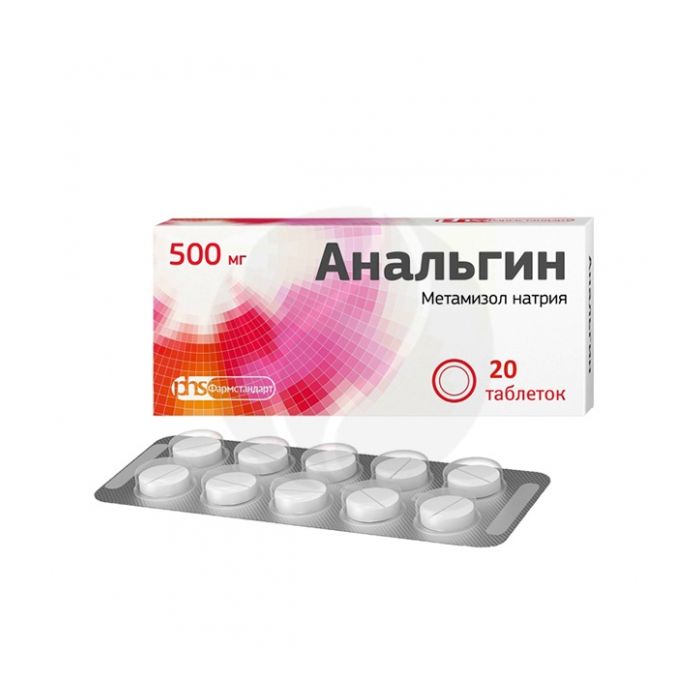Analgin tablets 500mg, No. 20
Expiration Date: 05/2027
Russian Pharmacy name:
Анальгин таблетки 500мг, №20
Pain syndrome of various etiologies:
headache;
migraine pain;
toothache;
neuralgia;
myalgia;
algodismenorrhea;
postoperative pain;
renal and biliary colic (in combination with antispasmodics);
feverish conditions in infectious and inflammatory diseases.
Inside, adults - 1 table. 2-3 times a day after meals. The maximum single dose is 1 g (table 2), daily dose is 3 g (table 6). With prolonged (more than a week) use of the drug, it is necessary to control the picture of peripheral blood and the functional state of the liver.
Children are prescribed 5-10 mg / kg of body weight 3-4 times a day for no more than 3 days (after crushing the tablet).
Do not use (without consulting a doctor) for more than 3 days when prescribed as an antipyretic agent and for more than 5 days when prescribed as an anesthetic.
Pills
1 tab.
active substance
metamizole sodium (analgin) 0.5 g
excipients: potato starch; sugar; calcium stearate; talc
in a contour non-cell or acheikova package 10 pcs.; in a carton box 1, 2, 3 or 5 packages.
Hypersensitivity to pyrazolone derivatives (butadione, tribuzone);
bronchial asthma;
diseases accompanied by bronchospasm;
'Aspirin asthma';
oppression of hematopoiesis (agranulocytosis, neutropenia, leukopenia);
severe impairment of liver or kidney function;
blood diseases;
hereditary hemolytic anemia associated with a deficiency of glucose-6-phosphate dehydrogenase;
pregnancy (especially in the first trimester and in the last 6 weeks);
lactation period.
With caution - infancy (up to 3 months).
pharmachologic effect
Analgesic antipyretic. Derived from pyrazolone. It has analgesic, antipyretic and anti-inflammatory effects, the mechanism of which is associated with inhibition of prostaglandin synthesis.
Side effect
Allergic reactions: skin rash, Quincke's edema; rarely - anaphylactic shock.
From the hematopoietic system: rarely, with prolonged use - leukopenia, agranulocytosis.
Local reactions: with intramuscular injection - infiltrates at the injection site.
Application during pregnancy and lactation
Use with caution during pregnancy, especially in the first trimester and in the last 6 weeks.
Application for violations of liver function
Contraindicated in severe liver dysfunction.
Application for impaired renal function
Contraindicated in severe renal impairment.
Application in children
Use with caution in children in the first 3 months of life.
Single doses for children aged 2-3 years are 50-100 mg; 4-5 years old - 100-200 mg; 6-7 years old - 200 mg; 8-14 years old - 250-300 mg; frequency of admission - 2-3 times / day.
special instructions
With prolonged use, it is necessary to control the peripheral blood picture.
Metamizole sodium is used in combination with pitofenone and fenpiverinium bromide as an analgesic with an antispasmodic effect.
Use with caution in children in the first 3 months of life.
Drug interactions
With simultaneous use with analgesics, antipyretics, with NSAIDs, mutual intensification of toxic effects is possible.
With simultaneous use with inducers of microsomal liver enzymes, it is possible to reduce the effectiveness of metamizole sodium.
With simultaneous use, the activity of indirect anticoagulants, oral hypoglycemic drugs, GCS, indomethacin increases due to their displacement from the connection with blood proteins under the influence of sodium metamizole.
With simultaneous use with phenothiazine derivatives, severe hyperthermia is possible; with sedatives, anxiolytics - the analgesic effect of metamizole sodium is enhanced; with tricyclic antidepressants, oral contraceptives, allopurinol - the metabolism of metamizole sodium is disrupted and its toxicity increases; with caffeine - the effect of sodium metamizole is enhanced; with cyclosporine - the concentration of cyclosporine in the blood plasma decreases.
When metamizole sodium is used in combination with pitofenone hydrochloride (it has a direct myotropic effect on the smooth muscles of internal organs and causes its relaxation) and with fenpiverinium bromide (m-anticholinergic blocker), their pharmacological action is mutually reinforced, which is accompanied by a decrease in pain syndrome, relaxation of smooth muscles and a decrease in elevated body temperature.

